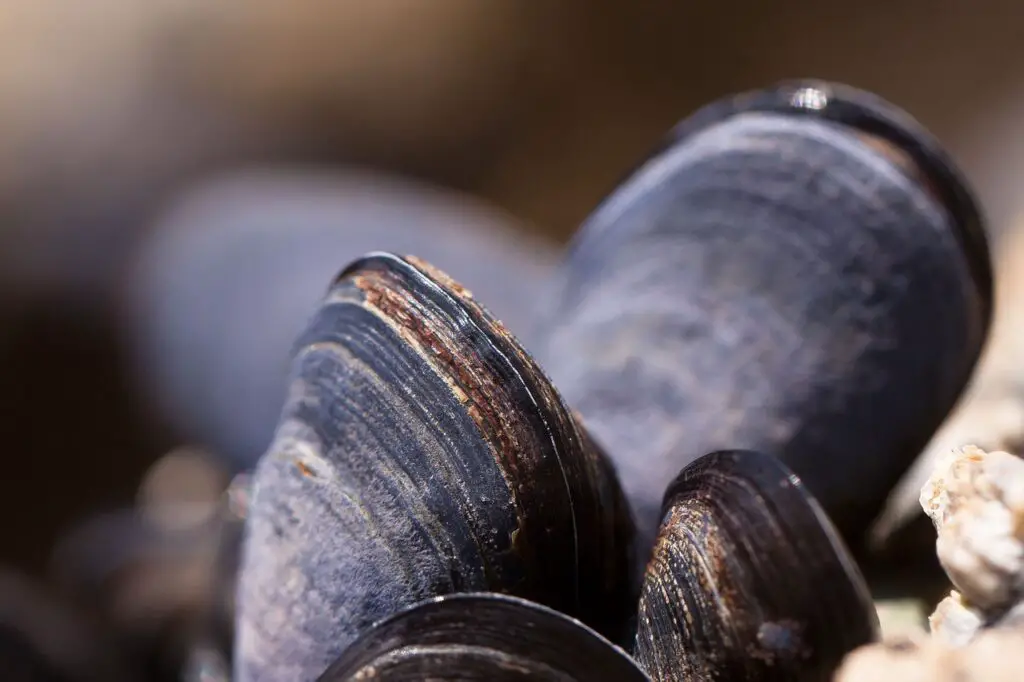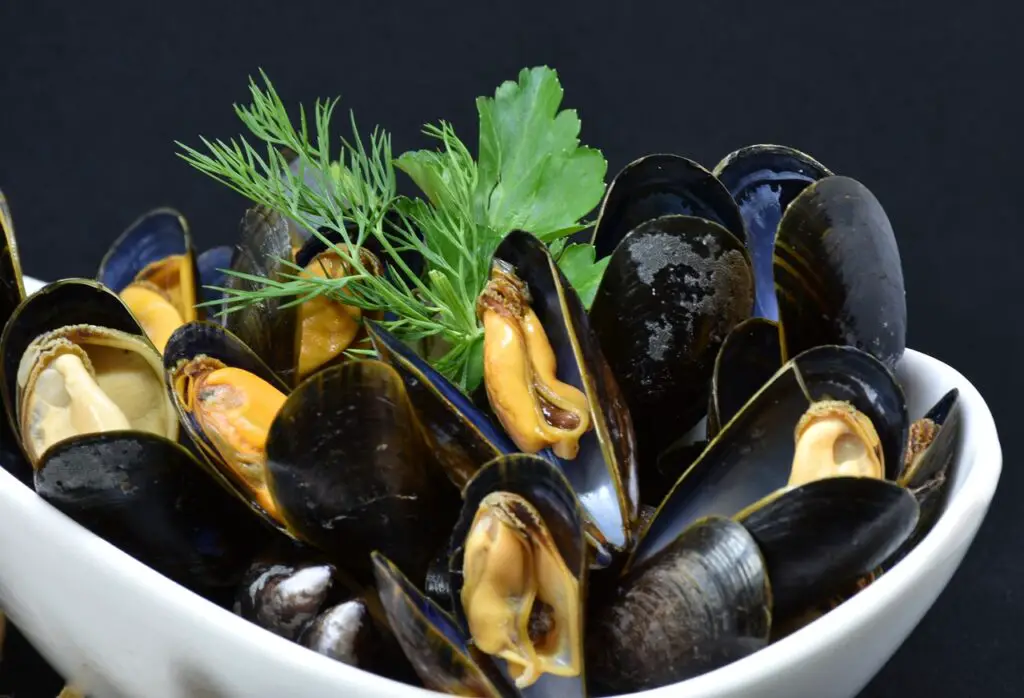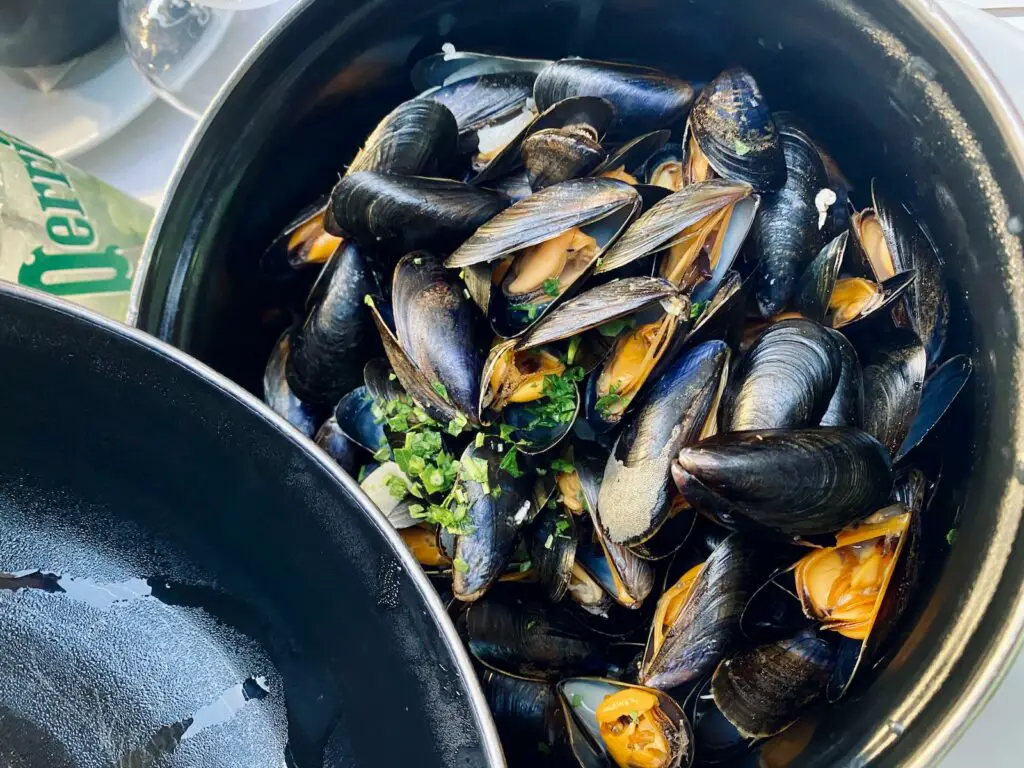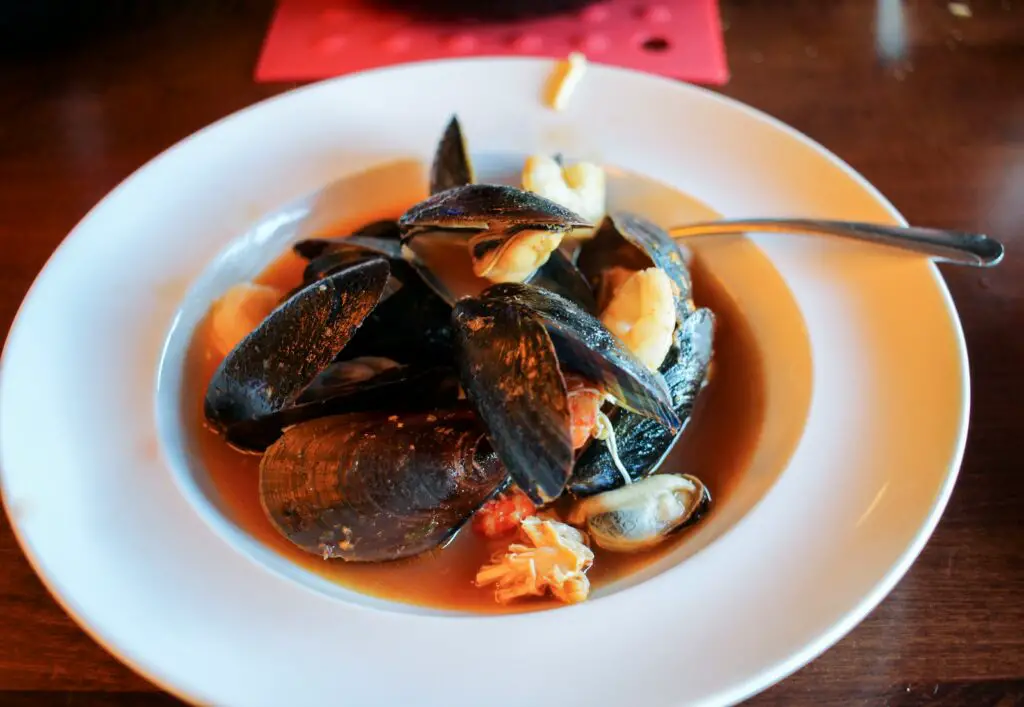
When it comes to cooking with mussels, it’s important to know how to tell if they are still fresh and safe to eat. Eating bad mussels can lead to food poisoning, which can cause nausea, vomiting, and diarrhea. It’s crucial to inspect the mussels before cooking them to ensure that they are not spoiled.
One of the easiest ways to tell if a mussel is bad is by smelling it. Fresh mussels should have a slightly salty and oceanic smell. If the mussels smell like ammonia or have a strong, fishy odor, it’s likely that they are spoiled. Another way to check if mussels are bad is by examining their shells. Fresh mussels should have tightly closed shells, while spoiled mussels will have open or cracked shells. If the shells are open, tap on them gently. If they close, it’s a sign that they are still alive and safe to eat.
Table of Contents
Identifying Fresh Mussels

When it comes to shellfish, freshness is key. Eating bad mussels can lead to food poisoning, so it’s important to know how to tell if a mussel is fresh or not. Here are some tips to help you identify fresh mussels:
- Look for live mussels: Fresh mussels should be alive when you buy them. They should be tightly closed, or if they’re open, they should close when you tap them. If a mussel is open and doesn’t close when you tap it, it’s dead and should be discarded.
- Check the shell: The shell of a fresh mussel should be shiny, smooth, and free of cracks or chips. If the shell is dull or rough, it may be an indication that the mussel is old or has been mishandled.
- Smell the mussel: Fresh mussels should have a mild, oceanic smell. If the mussel smells strong or unpleasant, it’s likely not fresh.
- Look for black mussels or green-lipped mussels: These types of mussels are known for their freshness and are often preferred by chefs. Black mussels have a dark, shiny shell, while green-lipped mussels have a greenish tint around the edge of their shells.
- Don’t buy pre-cooked mussels: Pre-cooked mussels may have been sitting in their own juices for too long and can spoil quickly. It’s best to buy live mussels and cook them yourself.
By following these tips, you can ensure that the mussels you’re buying are fresh and safe to eat.
Signs of Bad Mussels

When it comes to cooking mussels, it’s important to make sure that they are fresh and safe to eat. Here are some signs to look out for when determining if a mussel is bad.
Dead Mussels
Mussels that are already dead should be discarded immediately. Dead mussels will not open when cooked, and they can release toxins that can cause food poisoning. To check if a mussel is dead, gently tap it on a hard surface. If it doesn’t close, it’s dead and should be thrown away.
Open Mussels
Mussels that are open before cooking should also be discarded. Open mussels are a sign that they are dead or dying, and they can contain harmful bacteria. When buying mussels, make sure that they are tightly closed. If they are slightly open, tap them gently. If they don’t close, they are dead and should be discarded.
Bad Smell
Fresh mussels should have a salty ocean smell. If they have a strong, unpleasant odor, it’s a sign that they are bad and should not be eaten.
Bad Color
Fresh mussels should have a dark blue-black color. If they have a brown or green color, it’s a sign that they are bad and should not be eaten.
Bad Taste
If the mussels have a bad taste, it’s a sign that they are bad and should not be eaten. Fresh mussels should have a sweet, slightly salty taste.
In summary, when cooking mussels, it’s important to look out for signs of bad mussels, including dead or open shells, bad smell, bad color, and bad taste. If any of these signs are present, the mussels should be discarded immediately.
Proper Storage of Mussels

Proper storage of mussels is crucial to keep them fresh and safe to eat. Mussels are highly perishable and can spoil quickly if not handled correctly. Here are some tips on how to store mussels properly:
- Date the package: Always check the sell-by date on the package before buying mussels. If the date has passed, do not purchase them. Once you have bought the mussels, label the package with the date of purchase to help keep track of their freshness.
- Keep them cold: Mussels should be kept in the refrigerator at a temperature of 35 to 40 degrees Fahrenheit. Place them in a mesh bag or a bowl covered with a damp cloth to prevent them from drying out.
- Do not store in tap water: Never store mussels in tap water, as it will kill them. Instead, store them in a bowl of cold water with a pinch of salt. This will help keep them alive and fresh for a longer time.
- Rinse before cooking: Before cooking, rinse the mussels under cold running water to remove any dirt or debris. Discard any mussels that are open or do not close when tapped, as they may be dead and unsafe to eat.
By following these simple tips, you can ensure that your mussels are fresh and safe to eat. Always remember to check the sell-by date, keep them cold, and rinse them before cooking.
Preparation Before Cooking

Before cooking mussels, it is important to properly prepare them to ensure they are safe to eat and taste their best. Here are some steps to follow:
Clean and Scrub the Mussels
Start by scrubbing the mussels with a stiff brush under cold running water to remove any dirt, seaweed, or barnacles. This will also help to remove any sand or grit that may be trapped inside the shells. Discard any mussels that are open or have broken shells.
Soak the Mussels
Next, place the mussels in a large bowl of cold water and let them soak for about 20 minutes. This will help to remove any remaining sand or grit and help the mussels to open up.
Discard Any Mussels That Don’t Open
After soaking, discard any mussels that are still closed. This is a sign that they are dead and should not be eaten.
Store the Mussels
If you are not cooking the mussels right away, store them in the refrigerator in a bowl covered with a damp towel. Do not store them in water or airtight containers as this will cause them to suffocate and die.
By following these simple steps, you can ensure that your mussels are safe and delicious to eat.
Cooking Techniques for Mussels

Cooking mussels is a simple task, but it requires a bit of technique to ensure that they are cooked properly and safely. Here are some cooking techniques for mussels:
Steaming
Steaming is the most common way to cook mussels. To steam mussels, place them in a pot with a little bit of water or broth. Cover the pot and cook for 5-7 minutes or until the mussels have opened. Discard any mussels that do not open. Steamed mussels can be served with a variety of sauces or broths.
Boiling
Boiling mussels is another option. To boil mussels, place them in a pot of boiling water for 3-5 minutes or until they open. Discard any mussels that do not open. Boiled mussels can be served with a variety of sauces or broths.
Smoking
Smoked mussels are a delicious option for those who enjoy a smoky flavor. To smoke mussels, place them in a smoker for 20-30 minutes or until they are cooked through. Smoked mussels can be served on their own or added to dishes for extra flavor.
Barbecuing
Barbecuing mussels is a great way to add a charred flavor. To barbecue mussels, place them on a grill over high heat for 2-3 minutes or until they open. Discard any mussels that do not open. Barbecued mussels can be served on their own or added to dishes for extra flavor.
Roasting
Roasting mussels is another option. To roast mussels, place them in a preheated oven at 400°F for 10-15 minutes or until they open. Discard any mussels that do not open. Roasted mussels can be served on their own or added to dishes for extra flavor.
Frying
Fried mussels are a crispy and delicious option. To fry mussels, coat them in a batter and deep fry them for 2-3 minutes or until they are golden brown. Fried mussels can be served on their own or added to dishes for extra flavor.
Overall, there are many ways to cook mussels. The key is to ensure that they are cooked properly and safely. By following these cooking techniques, you can enjoy delicious and flavorful mussels in a variety of dishes.
Safety Measures

When it comes to consuming mussels, it is essential to take safety measures to avoid any risk of food poisoning. Here are some safety measures to keep in mind:
- Buy mussels from a reputable source: Always purchase mussels from a trusted fishmonger or grocery store. Check the sell-by date and ensure that the mussels are stored in a clean, refrigerated environment.
- Inspect the mussels: Before cooking, inspect the mussels to ensure that they are safe to eat. Discard any mussels that are open or have broken shells. Also, discard any mussels that have a strong, unpleasant odor.
- Cook the mussels thoroughly: Cooking mussels thoroughly is crucial to kill any harmful bacteria or viruses that may be present. Steam mussels for at least 5-6 minutes or until the shells open. Boil mussels for at least 3-4 minutes or until the shells open.
- Store leftovers properly: If you have any leftover mussels, store them in an airtight container in the refrigerator. Consume them within 1-2 days to avoid any risk of food poisoning.
By following these safety measures, you can ensure that the mussels you consume are safe to eat and avoid any risk of food poisoning.
Delicious Mussel Recipes
Mussels are a versatile seafood that can be cooked in a variety of ways. Here are some delicious mussel recipes that are easy to prepare and sure to impress.
Spiced Mussels in Tomato Sauce
This recipe is perfect for those who love a bit of spice in their food. The mussels are cooked in a rich tomato sauce with a blend of spices that give it a kick.
Ingredients:
- 2 lbs mussels
- 1 can of chopped tomatoes
- 2 cloves of garlic, minced
- 1 onion, chopped
- 1 tsp cumin
- 1 tsp coriander
- 1 tsp paprika
- 1/2 tsp cayenne pepper
- Salt and pepper to taste
- Olive oil
Instructions:
- Clean and debeard the mussels.
- In a large pot, heat some olive oil over medium heat.
- Add the garlic and onion and sauté until the onion is translucent.
- Add the chopped tomatoes and spices and simmer for 5 minutes.
- Add the mussels and cover the pot.
- Cook for 5-7 minutes or until the mussels have opened.
- Discard any mussels that have not opened.
- Serve with crusty bread.
Mussels in White Wine Sauce
This classic recipe is simple yet delicious. The mussels are cooked in a white wine sauce with butter, garlic, and lemon.
Ingredients:
- 2 lbs mussels
- 1 cup dry white wine
- 2 cloves of garlic, minced
- 2 tbsp butter
- Juice of 1 lemon
- Salt and pepper to taste
- Parsley for garnish
Instructions:
- Clean and debeard the mussels.
- In a large pot, melt the butter over medium heat.
- Add the garlic and sauté until fragrant.
- Add the white wine and bring to a boil.
- Add the mussels and cover the pot.
- Cook for 5-7 minutes or until the mussels have opened.
- Discard any mussels that have not opened.
- Add the lemon juice and season with salt and pepper.
- Serve with parsley and crusty bread.
Mussel and Chorizo Stew
This hearty stew is perfect for a cozy night in. The mussels are cooked with spicy chorizo, potatoes, and a flavorful broth.
Ingredients:
- 2 lbs mussels
- 1 lb chorizo, sliced
- 2 potatoes, diced
- 1 onion, chopped
- 2 cloves of garlic, minced
- 4 cups chicken broth
- 1 tsp smoked paprika
- Salt and pepper to taste
- Olive oil
Instructions:
- Clean and debeard the mussels.
- In a large pot, heat some olive oil over medium heat.
- Add the chorizo and sauté until browned.
- Add the onion and garlic and sauté until the onion is translucent.
- Add the potatoes and chicken broth and bring to a boil.
- Add the mussels and cover the pot.
- Cook for 5-7 minutes or until the mussels have opened.
- Discard any mussels that have not opened.
- Season with smoked paprika, salt, and pepper.
- Serve with crusty bread.
These mussel recipes are just a few examples of the many ways to enjoy this delicious seafood. Whether you prefer a spicy tomato sauce or a classic white wine sauce, there is a mussel recipe for everyone.
Health Benefits of Consuming Mussels
Mussels are not only delicious but also packed with nutrients that are beneficial for human health. Here are some of the health benefits of consuming mussels:
Rich in Iron
Mussels are an excellent source of iron, which is an essential mineral that helps in the production of red blood cells. Iron is also necessary for the proper functioning of the immune system and the metabolism. A 100-gram serving of mussels contains approximately 6.7 milligrams of iron, which is about 37% of the daily recommended intake for adults.
High in Vitamin B12
Mussels are also a great source of vitamin B12, which is important for the proper functioning of the nervous system and the production of red blood cells. Vitamin B12 is also necessary for the metabolism of carbohydrates, proteins, and fats. A 100-gram serving of mussels contains approximately 20 micrograms of vitamin B12, which is about 833% of the daily recommended intake for adults.
Contains Essential Vitamins
Mussels are also a good source of other essential vitamins, including vitamin C, vitamin E, and vitamin K. Vitamin C is an antioxidant that helps in the repair and growth of tissues, while vitamin E is important for the proper functioning of the immune system. Vitamin K is necessary for the proper functioning of the blood clotting system.
Healthy Mussels
It is important to note that the health benefits of mussels depend on their quality. Mussels that are harvested from polluted waters may contain harmful toxins that can cause health problems. Therefore, it is important to choose mussels that are harvested from clean waters and to cook them properly to reduce the risk of foodborne illness.
In conclusion, mussels are a delicious and nutritious food that is rich in iron, vitamin B12, and other essential vitamins. However, it is important to choose healthy mussels and to cook them properly to ensure their safety and to maximize their health benefits.
Comparing Mussels with Other Shellfish
When it comes to comparing mussels with other shellfish, there are a few key differences to keep in mind. While mussels are filter feeders like clams and oysters, they have some unique characteristics that set them apart.
One of the main differences between mussels and other shellfish is their texture. Mussels have a slightly chewy texture, while clams and oysters tend to be more tender. This is due to the fact that mussels have a thicker, tougher shell and a larger, meatier body.
Another difference is in the taste. Mussels have a distinct, briny flavor that is often described as “oceanic.” Clams and oysters, on the other hand, have a milder, sweeter taste that is often paired with lemon or other acidic flavors.
When it comes to sourcing, mussels are often farmed, while clams and oysters can be either farmed or wild-caught. This means that mussels are generally more sustainable and easier to find year-round.
In terms of safety, all shellfish can be prone to bacterial contamination if not handled properly. It’s important to only purchase shellfish from reputable sources and to always cook them thoroughly before eating.
Overall, while mussels share some similarities with other shellfish, they have their own unique characteristics that make them a delicious and nutritious addition to any seafood dish.
Regulations and Standards
When it comes to mussels, there are regulations and standards in place to ensure that they are safe for consumption. In New Zealand, the Ministry for Primary Industries (MPI) sets the standards for the harvesting and processing of mussels. The MPI has strict regulations in place to ensure that mussels are safe to eat and are of high quality.
One of the key regulations in New Zealand is the requirement for all mussel farms to be registered with the MPI. This ensures that the farms are regularly inspected and that they meet the standards set by the MPI. The MPI also has strict guidelines in place for the harvesting and processing of mussels. These guidelines cover everything from the water quality to the handling of the mussels.
In addition to the regulations set by the MPI, there are also industry standards that mussel farmers must adhere to. These standards cover everything from the size and weight of the mussels to the handling and packaging of the final product. These standards are in place to ensure that consumers receive high-quality mussels that are safe to eat.
When purchasing mussels, it is important to look for those that have been harvested and processed in accordance with these regulations and standards. This will ensure that you are getting a safe and high-quality product. It is also important to purchase mussels from a reputable source, as this will further reduce the risk of consuming bad mussels.
Overall, the regulations and standards in place for the harvesting and processing of mussels in New Zealand are designed to ensure that consumers receive safe and high-quality products. By purchasing mussels that have been harvested and processed in accordance with these regulations and standards, consumers can be confident that they are getting a safe and delicious product.